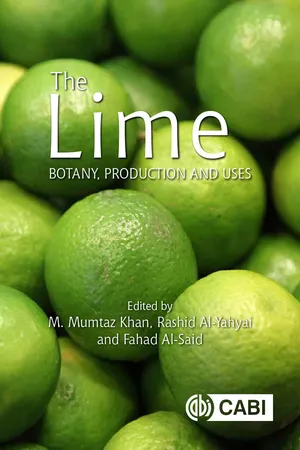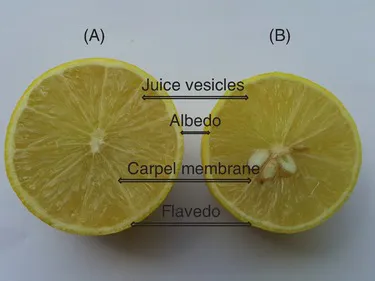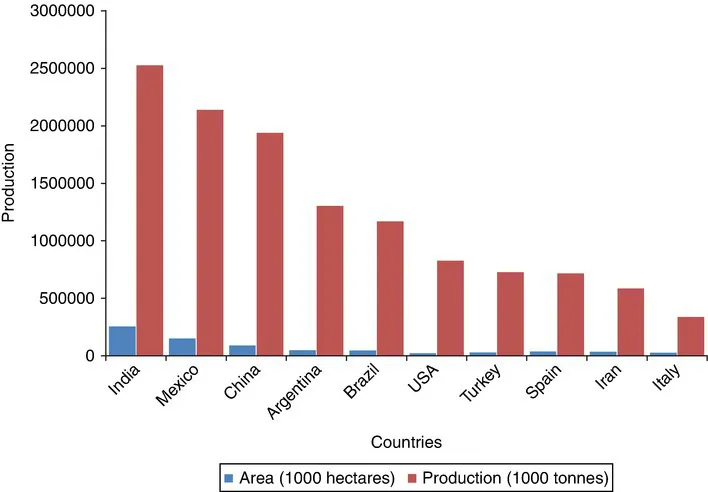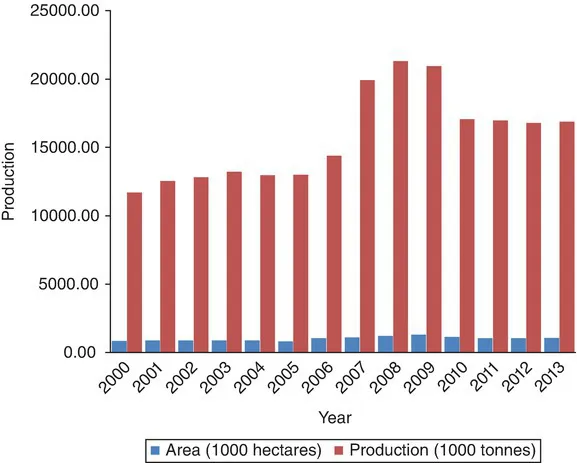
eBook - ePub
Lime, The
Botany, Production and Uses
M Mumtaz Khan, Rashid Al-Yahyai, Fahad Al-Said, M Mumtaz Khan, Rashid Al-Yahyai, Fahad Al-Said
This is a test
- English
- ePUB (adapté aux mobiles)
- Disponible sur iOS et Android
eBook - ePub
Lime, The
Botany, Production and Uses
M Mumtaz Khan, Rashid Al-Yahyai, Fahad Al-Said, M Mumtaz Khan, Rashid Al-Yahyai, Fahad Al-Said
Détails du livre
Aperçu du livre
Table des matières
Citations
À propos de ce livre
The lime is an important fruit crop throughout the citrus producing regions of the world, with its own specific benefits and issues affecting successful cultivation and production. Limes: Botany, Production and Uses covers the breeding, genetics and biodiversity of the plants, and explains the processes for establishing a lime orchard, including propagation techniques, pruning and thinning of established trees, water requirements and irrigation systems. All the major problems of lime cultivation are explored and discussed, including increasing threats such as Witches' Broom Disease and Citrus Greening, along with approaches for pest and disease management and prevention.
Foire aux questions
Comment puis-je résilier mon abonnement ?
Il vous suffit de vous rendre dans la section compte dans paramètres et de cliquer sur « Résilier l’abonnement ». C’est aussi simple que cela ! Une fois que vous aurez résilié votre abonnement, il restera actif pour le reste de la période pour laquelle vous avez payé. Découvrez-en plus ici.
Puis-je / comment puis-je télécharger des livres ?
Pour le moment, tous nos livres en format ePub adaptés aux mobiles peuvent être téléchargés via l’application. La plupart de nos PDF sont également disponibles en téléchargement et les autres seront téléchargeables très prochainement. Découvrez-en plus ici.
Quelle est la différence entre les formules tarifaires ?
Les deux abonnements vous donnent un accès complet à la bibliothèque et à toutes les fonctionnalités de Perlego. Les seules différences sont les tarifs ainsi que la période d’abonnement : avec l’abonnement annuel, vous économiserez environ 30 % par rapport à 12 mois d’abonnement mensuel.
Qu’est-ce que Perlego ?
Nous sommes un service d’abonnement à des ouvrages universitaires en ligne, où vous pouvez accéder à toute une bibliothèque pour un prix inférieur à celui d’un seul livre par mois. Avec plus d’un million de livres sur plus de 1 000 sujets, nous avons ce qu’il vous faut ! Découvrez-en plus ici.
Prenez-vous en charge la synthèse vocale ?
Recherchez le symbole Écouter sur votre prochain livre pour voir si vous pouvez l’écouter. L’outil Écouter lit le texte à haute voix pour vous, en surlignant le passage qui est en cours de lecture. Vous pouvez le mettre sur pause, l’accélérer ou le ralentir. Découvrez-en plus ici.
Est-ce que Lime, The est un PDF/ePUB en ligne ?
Oui, vous pouvez accéder à Lime, The par M Mumtaz Khan, Rashid Al-Yahyai, Fahad Al-Said, M Mumtaz Khan, Rashid Al-Yahyai, Fahad Al-Said en format PDF et/ou ePUB ainsi qu’à d’autres livres populaires dans Biological Sciences et Botany. Nous disposons de plus d’un million d’ouvrages à découvrir dans notre catalogue.
Informations
Sujet
Biological SciencesSous-sujet
Botany1 Introduction and Overview of Lime
1Department of Crop Sciences, College of Agricultural and Marine Sciences, Sultan Qaboos University, Muscat, Oman; 2Assistant Secretary General for Innovation Development, The Research Council, Muscat, Oman
*E-mail: [email protected]
Lime, lemon and citron belong to the acid citrus fruit group. This group is characterized by an elliptical to round shaped fruit with high citric acid content. Limes can be distinguished from other fruit in the citrus family as they have both acid and sweet varieties. The differences in tree morphology and fruit characteristics may even be sufficient to confer the status of separate species for the acid and sweet types. All citrus fruits have nearly the same structure; however, the elements that comprise these structures vary according to species and variety (Loussert, 1992). The external part of the rind consists of several morphologically different tissues called flavedo because of the presence of flavonoid compounds (Ortiz, 2002). The whole surface of the fruit is covered by polygonal cells to form the isodiametric layer. This layer contains cuticles that are partially enclosed with a waxy substance to prevent excessive loss of water from the fruit. A layer made of collenchyma and parenchyma cells is present under the layer of epidermis, where many oil glands containing essential oil are located at different depths within the parenchyma tissues. The white spongy part of the parenchyma, called the albedo, is located under the layers of collenchyma and parenchyma (Ting and Attaway, 1971). The name albedo is derived from the Latin (albus = white) (Ortiz, 2002). The edible part of the fruit is divided by carpel segments or locules. There are many juice vesicles within the carpels (Ting and Attaway, 1971; Rivera-Cabrera et al., 2010) (Fig. 1.1). The number of carpels vary, with acid lime fruit normally containing around 8–11 segments (Loussert, 1992).

Fig. 1.1. Cross-section of lime fruit. (A) Persian lime, (B) Mexican. (Derived from Rivera-Cabrera et al., 2010.)
The lime plant belongs to the kingdom Plantae; phylum Magnoliophyta; class Magnoliopsida; order Sapindales; family Rutaceae; genus Citrus; and species aurantifolia (Sethpakdee, 1992). The three main types of lime largely cultivated worldwide are Persian lime, Key lime (Mexican lime) and Makrut lime (Table 1.1). Key limes are a small rounded fruit (Citrus aurantifolia (Christ.) Swingle), while the Persian limes bear a larger fruit (Citrus latifolia Tanaka) that is triploid and seedless. The Persian lime is the most frequently grown lime variety globally and México is one of the major producing countries. The fruit has an elliptical shape, thin, smooth skin and is juicy with an acidic lime aroma. Less heat is needed for Persian lime fruit maturity than for Key limes, and they are more cold- and frost-tolerant (Reuther et al., 1967). The Makrut lime is produced in smaller amounts and is very popular in South-east Asian cookery. The fruit is small sized, the skin is rough and the leaves are aromatic and used in cuisine (Reuther et al., 1967).
Table 1.1. Description of major lime varieties.
| Lime type | Other names | Appearance |
| Key lime (Citrus × auratifolia) | West Indian, Bartenders, Omani, Mexican | 2.5–5 cm. diameter, high acidity, strong aroma, tart and bitter,7–8% citric acid |
| Persian lime (Citrus × latifolia) | Shiraz limoo, Tahitian, Bearss (seedless) | 5–12.7 cm. diameter, slight nippled end, ripens to yellow but sold green |
| Makrut lime (Citrus × hystrix) | Kaffir | 5 cm. diameter rough bumpy skin, thick rind, aromatic leaves used in cooking |
Source: Reuther et al., 1967
The Key lime (Citrus aurantifolia (Christ.) Swingle), is a polyembryonic species, grown globally, generally in warm tropical to subtropical regions such as India, México, the USA, Egypt and the West Indies (Morton, 1987). There are many common names used for Key lime, including West Indian lime, Mexican lime, Egyptian lime, Bilolo and Dayap, etc. The Key lime (C. aurantifolia Swingle) is mostly known as tri-hybrid, evolved through an inter-generic cross (a three-way hybrid where three plant species are involved and at least two different genera) of citron (Citrus medica), pummelo (Citrus grandis) and a Microcitrus species (Citrus micrantha).
The Key lime plant is spiny, less vigorous and less robust compared with Persian lime trees, and requires more heat for fruit development. It produces smaller fruit when it is grown in the Mediterranean climate due to the sporadic cold snaps and lower temperature regimes (Reuther et al., 1967). On the other hand, it grows vigorously in tropical environments and produces higher yields.
History, Origin and Distribution
It has been suggested that the lime perhaps evolved from a tri-hybrid cross amongst C. medica, C. grandis and a Microcitrus species (Barrett and Rhodes, 1976). However, another study reported that mandarin was a parent of lime, while another parent could be citron, pummelo or Papeda (Handa et al., 1986). Recent studies have strongly argued that Key lime was a hybrid of Papeda and Citron. The molecular evidence of these studies offered more conclusive information compared with all previous studies reported relating to the origin of lime (Li et al., 2010). Like Key lime, ‘Tahiti’ lime is probably a tri-hybrid inter-generic cross of citron (C. medica), pummelo (C. grandis) and a Microcitrus species, C. micrantha (Moore, 2001). However, unlike Key lime, ‘Tahiti’ lime is a triploid.
The ancestral place of lime origin is also controversial, similar to that of other citrus species, but many researchers and historians believe that lime originated from South-east Asia around 4000 bc and its native home is the Indo-Malayan region (Nicolosi et al., 2000). It is believed that the Europeans were not familiar with this fruit before the crusades, and it was Arab travellers who carried it to North Africa and the Near East. After the crusades it was taken to Palestine and then finally spread to Mediterranean Europe (Cooper and Chapot, 1977; Eckert and Eaks, 1989). During the middle of the thirteenth century, it was thought to be cultivated in some parts of Italy, France, Spain and Portugal. It was introduced in México during the time of Spanish colonization. It is strongly believed that both Portuguese and Spanish voyagers took it to the Americas during the early sixteenth century (Ziegler and Wolfe, 1961). Once introduced as an exotic plant, it has shown wide adaptation to diverse climates and was largely naturalized in México, the Caribbean, tropical areas of South America, Central America and the Florida Keys. During 1839 its cultivation started to expand in Florida and it was developed as a common home yard fruit. By 1883 it began to be produced on a small scale commercially in south-central Florida.
A hurricane in 1906 along with soil nutrient depletion resulted in the pineapple culture being abandoned. At that time, people began to plant limes as a substitute crop on the west coast of Florida. Lime fruit pickles became a prime snack choice among schoolchildren in Boston. A small-scale lime pickle business was active from 1913 to 1923 but it crumbled in 1926 due to the devastating impact on lime groves of another hurricane. Afterwards, the lime was largely grown as a common yard and garden plant in the Keys and the southern part of the Florida mainland.
In the Middle East, lime is a major traditional crop that has been used for a variety of culinary and medicinal purposes. Both fresh and dried limes are used for juice and as a condiment for food flavouring. Historically, sun-dried limes were a major export commodity of Oman, and are frequently used in sauces and as a flavouring agent in other Arab cuisines. Oman is a leading lime-producing country in the region. However, lime production has been drastically reduced in recent decades due to the spread of witches’ broom disease of lime (WBDL), which has reduced the cultivated area to less than half since 1990 (Al-Yahyai et al., 2012). Since its discovery in the 1970s, the disease has spread to other countries in the Middle East, including the United Arab Emirates (UAE), Saudi Arabia and Iran, threatening many major lime-producing countries.
Global Lime Production
Mexican lime is largely cultivated in tropical and subtropical areas of the globe. It is grown commercially, semi-commercially and in gardens. Lime is cultivated on a range of continents all over the globe, particularly in Asia and the Americas (Fig. 1.2a). Lime and lemon are mainly grown in India, México, China, Argentina, Brazil, the USA, Turkey, Spain, Iran and Italy (FAOSTAT, 2016). The percentage share of the top ten lime and lemon-producing countries is presented in Fig. 1.2b.

Fig. 1.2. The percentage of lime and lemon production on different continents (a) and top ten global producers in 2013 (b). (Source: FAOSTAT, 2016.)
The relationship between area planted and production of the major lime-producing countries becomes clearer regarding total area under crop and the total harvest during 2013 upon examination of Fig. 1.3. Recognizing the importance of lime and lemon for both domestic and industrial uses, their cultivation has been increased considerably throughout the globe since 2000 (Fig. 1.4).

Fig. 1.3. Lime and lemon production and area harvested in top ten producing countries during 2013. (Source: FAOSTAT, 2016.)

Fig. 1.4. Lime and lemon production and area harvested 2000–2013. (Source: FAOSTAT, 2016.)
It is noteworthy to observe the tremendous increase in yields, which may be attributed to better plant material and the advancement in technologically driven crop management. The fruit yield was 13 million tonnes during 2005 and has recently been maintained at approximately 18.9 million tonnes from 2010 to 2013 (FAOSTAT, 2016). Lime-producing countries harvest fruit for both domestic consumption and export. It is interesting to note that the top lime-producing country (India) has negligible lime exports, while Spain and México had the highest quantity of lime exported during 2013 (Fig. 1.5a)....
Table des matières
- Cover
- Half Title
- Title
- Copyright
- Contents
- Contributors
- Preface
- About the Editors
- 1 Introduction and Overview of Lime
- 2 Systematic Classification, Distribution and Botany
- 3 Advances in Lime Breeding and Genetics
- 4 Growth, Development and Reproductive Physiology of the Mexican Lime (Citrus aurantifolia Christm (Swingle))
- 5 Propagation and Nursery Certification
- 6 Planning and Orchard Establishment
- 7 Irrigation and Fertilization Management in Lime Trees
- 8 Cultural Practices
- 9 Precision Agriculture in Lime: Potential for Application of Precision Agriculture Technologies in Lime Cropping Systems
- 10 Plant Protection: Lime Diseases and Insect Pests
- 11 Innovative Production Technologies
- 12 Harvesting and Post-harvest Management
- 13 Traditional/Commercial Uses and Future Dynamics
- Index
- Back Cover
Normes de citation pour Lime, The
APA 6 Citation
[author missing]. (2017). Lime, The ([edition unavailable]). CABI. Retrieved from https://www.perlego.com/book/969408/lime-the-botany-production-and-uses-pdf (Original work published 2017)
Chicago Citation
[author missing]. (2017) 2017. Lime, The. [Edition unavailable]. CABI. https://www.perlego.com/book/969408/lime-the-botany-production-and-uses-pdf.
Harvard Citation
[author missing] (2017) Lime, The. [edition unavailable]. CABI. Available at: https://www.perlego.com/book/969408/lime-the-botany-production-and-uses-pdf (Accessed: 14 October 2022).
MLA 7 Citation
[author missing]. Lime, The. [edition unavailable]. CABI, 2017. Web. 14 Oct. 2022.